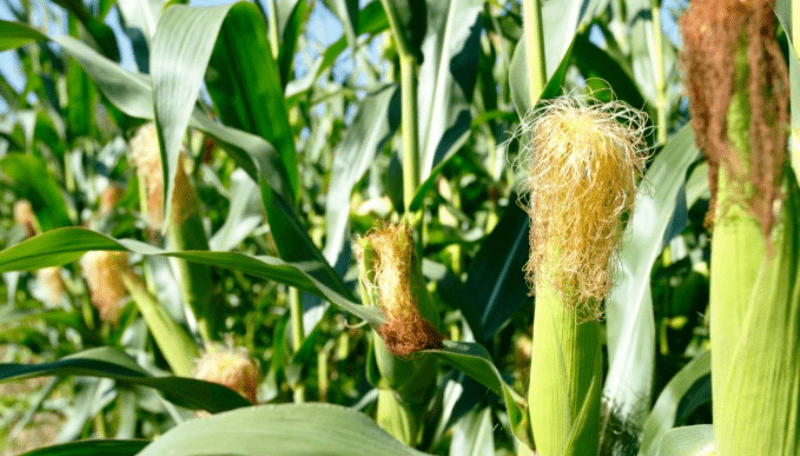
Maize Cultivation in India – Guide to Maize Production

Maize ranks third as a core food crop of India. It is a versatile crop and can grow in a wide variety of geographic conditions. It can be cultivated throughout the year also.
India’s largest maize producing states are Karnataka, Andhra, Bihar, Maharashtra, Himachal Pradesh, Uttar Pradesh, and Rajasthan. Although it is a staple food, it also serves as a basic raw material for proteins, starches, oils, alcoholic beverages, cosmetics, gum, paper and packaging industries, etc.
Maize Cultivation in India
Maize grows as tall as 10 feet in height. Some natural strains can even attain heights of 43 feet. The stem is very thick and round, and the roots are fibrous, running deep into the soil.
The leaves are linear and long, and both male and female flowers grow in different parts of the plant. Male flowers grow in a cluster at the upper end of the stem, while female flowers are produced inside the cob. Corn grains are round, disc-like and range in colour from creamy white, yellow, orange to red and purple. Corn varieties vary in crop duration, height, size and seed colour, structure and even use.
Maize farming operations require reliable equipment for every Indian farmer; Hence, we suggest Swaraj 717, which is great for the Indian farmers and frequently used in farming. Along with this, the Sonalika 60 tractor is also excellent.
Climate for Maize Cultivation
Maize cannot tolerate frost, and hence farmers sow the Kharif crop just before the monsoons arrive in India. It requires about 70 mm of rainfall. Alternate spells of sunshine and rain are optimal for maize production. It can tolerate temperatures up to 35⁰C.
The Season For Maize Production
Since maize requires the best rainfall, followed by healthy sunlight, it is a Kharif crop. Therefore, farmers mostly sow during June and July. However, they also sow it during the months of January-February and September-October. In the case of seed production, the maturity period of the seed should not coincide with the monsoon. So farmers do sowing in November and December for seed production.
Soil for Maize Production in India
The pH value of soil is 5.5 to 7.0, and a good drainage capacity is preferable for maize cultivation. Loamy sand, black soil and even clay loam are suitable for maize. Both red soil and alluvium are considered suitable for the cultivation of maize.
However, it requires the best amount of organic matter, even in highly fertile soils. In the case of black soil of clay type, it is advisable to add a sufficient amount of sand to increase the drainage capacity of the soil. Water holding soil is not preferred for maize cultivation.
Crop Rotation with Maize Crop
Farmers can grow the maize as a single crop in a year or as 2-3 crops in a single year as both short and long duration crop varieties are available. In areas where farmers grow the maize as a mixed crop, shorter varieties are grown between tall maize plants.
When the short duration variety of maize is cultivated, it is usually interspersed with crops such as potatoes, beans, peppers, chrysanthemums, onions, etc. Some farmers also develop ragi, although it is a cereal crop. In places like Uttar Pradesh, where farmers grow maize as a field crop, carrot or wheat is subordinate.
Water Requirement in Maize Production
Maize is sensitive to both under-water and excess water. Therefore, well-drained soil is preferred, which retains a sufficient amount of moisture and retains water. In other words, farmers should regulate irrigation as per the requirement.
They should also maintain the moisture level optimally during the flowering stage, which is important for maximum yield production. Drip irrigation once every 2 days is the most preferred method of irrigation as it ensures to maintain the moisture at optimum level.
Manuring
Once the ground is level, organic manure such as animal manure is added, ploughed and re-harrowed. 7-8 tonnes of manure is required per acre. Azospirillum and Coir pith can be used in place of cattle and farm manure.
Maize Cultivation – Irrigation
Farmers must irrigate the land a day before actual sowing to have enough moisture during the sowing. Then, once again, they irrigate immediately after sowing.
The crop requires irrigation on the third day after sowing in case there are no rains. It is recommended to irrigate the field as soon as dryness in the soil. However, during the early growth stage, farmers must care to avoid water stagnation in the field, and irrigation after 30 days of growth once a week is usually sufficient.
The tractor is an important part of maize cultivation; Thus, we suggest that the Eicher 333 is best in this farming process. Also, you can use Powertrac 439 Tractor. Along with this, Powertrac 434 Plus is also the best tractor.
For more information regarding maize farming, stay tuned with us.